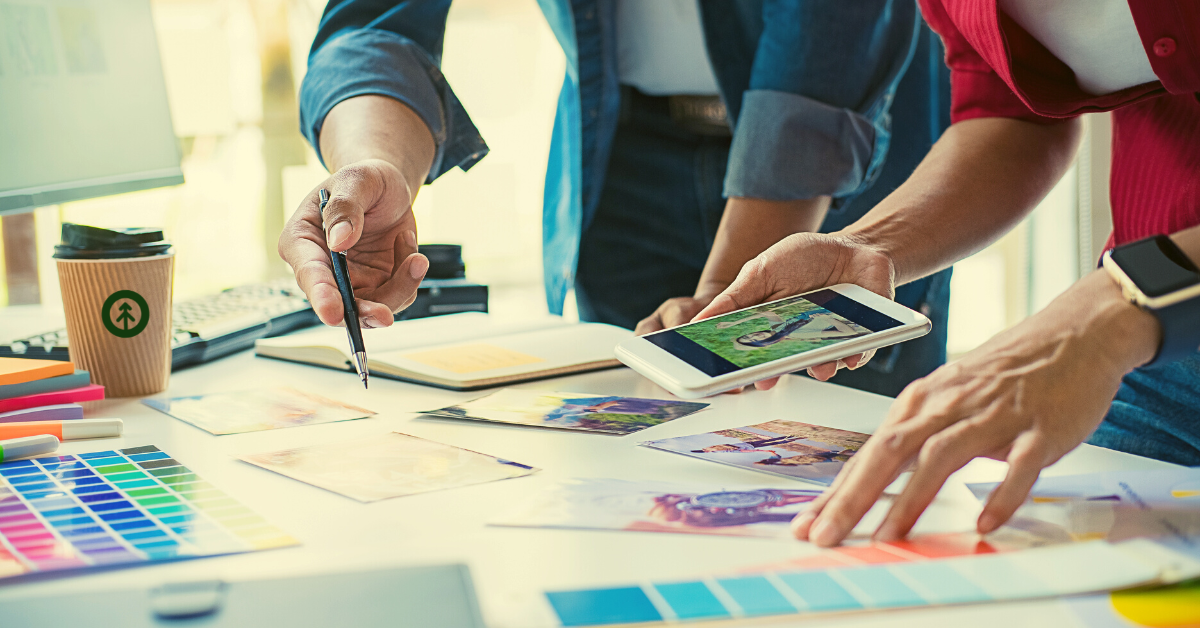Everyone loves a good story. And from cave paintings to Tik Tok, humans have been using storytelling as a powerful tool to capture an audience and convey an unforgettable message.
And in the world of website design, storytelling is the secret sauce that inspires emotional connection between users and brands.

Storytelling in website design:
- creates an emotional connection with users
- guides & directs users through websites (UI)
- builds a cohesive and engaging experience (UX)
- inspires connection that defines & promotes your brand
By weaving a strong narrative throughout the design of a website—combining color, copy, images, typography, and smart UX design concepts—designers create visual, interactive, and intuitive experiences that align with the goals and expectations of website visitors.
Typography, Image, Color: BAM!
When we think of stories, our first thought might be language and words. But how often do we think about how typography, color, and image inspire us and keep us engaged and delighted while being told a story?
It takes exceptional talent to not only notice how these aspects work in a story but to know how to use them—and then execute that knowledge in a website project.
By carefully selecting images and typography that align with the overall story of the brand, website designers can create a visual narrative that guides users through the site.
Typography
Typography—font choice—creates a mood and conveys the style of the brand.
A serif font like Times New Roman says something completely different from a sans serif font like Arial, for instance.
But who thinks of these things? Designers!
And it’s one way that they create designs that tell stories that stay with you or inspire you to act.
Color + Image
Colors have deep, consistent meanings for all humans, and they have the power to influence how we interact with and understand concepts.
And we associate feelings, memories, and ideas with colors, whether we’re conscious of it or not.
It’s the job of a designer to understand this and choose images with colors that weave a consistent story throughout the design to tap into those deep human emotions.
This can be especially effective in e-commerce sites, where storytelling can be used to create an emotional connection with products and help users make a purchase decision.
UX Design

User experience (UX) design tells a story that users usually don’t notice—but they feel it.
By carefully designing the user flow of a website to align with the overall story of the website and brand, designers can create a seamless, intuitive experience.
This can be especially effective in helping users make purchasing decisions.
Micro-Interactions
Micro-interactions are small animations and interactions that are used to provide feedback to users and guide them through a website.
When you mouse over a button or image, and it moves or changes color to help you understand your interaction with the site, you’ve found yourself under the spell of a micro-interaction.
When it’s connected to the overall story of the brand, it’s one more delight that reminds you how special this brand is.
It inspires you to act.
By carefully designing micro-interactions that align with the overall story of the brand, designers can create an immersive and engaging experience for users that inspire customers and visitors to become promoters of the brand.
Copywriting
When a copywriter uses strong verbs and nouns, the result is a tactile image that can inspire in the same way an image or sound evokes meaning and emotion.
A copywriter’s job is to choose specific words that show personality, brand voice, mood, and appeal as much as meaning.
For instance, think of the word “child” vs. “kid.” They both mean “a young human,” but the impact is completely different.
A good website designer knows how to work with a copywriter (and vice versa) to create a brand voice alongside helpful, relevant information that can be woven throughout the entire site.
And the use of words to create a consistent mood that aligns with the story of the brand guides users toward the action the website was designed to perform.
Next time you look at a website, notice the design and how it works to inspire you. You’re welcome!
Growth’s website design team is led by our award-winning designer, Sarah Dinsmore, who knows how to ask the right questions of our clients throughout the design process to understand the exact story she needs to tell about their brand.
Her keen knowledge of design concepts and brilliant insights drives our clients’ story-driven websites that delight just as much as they convert visitors into promoters of brands.
Sound like the exact type of website you need? Tell us all about it. We’re here to listen to what story your business wants to tell and launch it forward.
